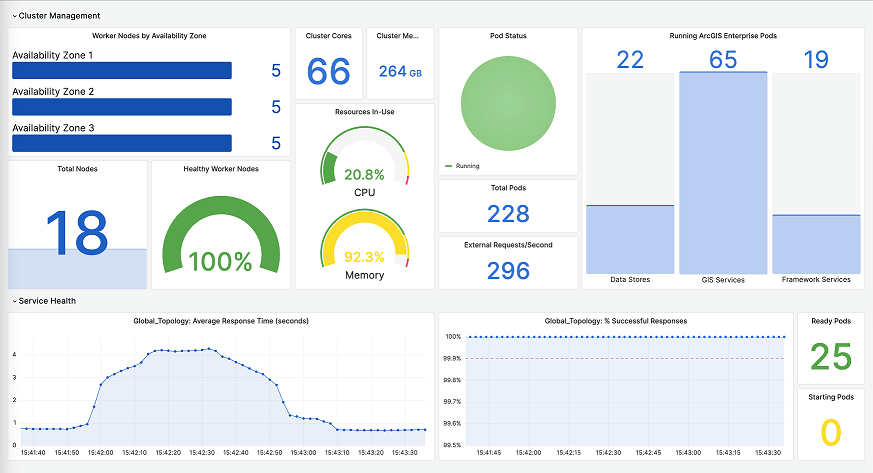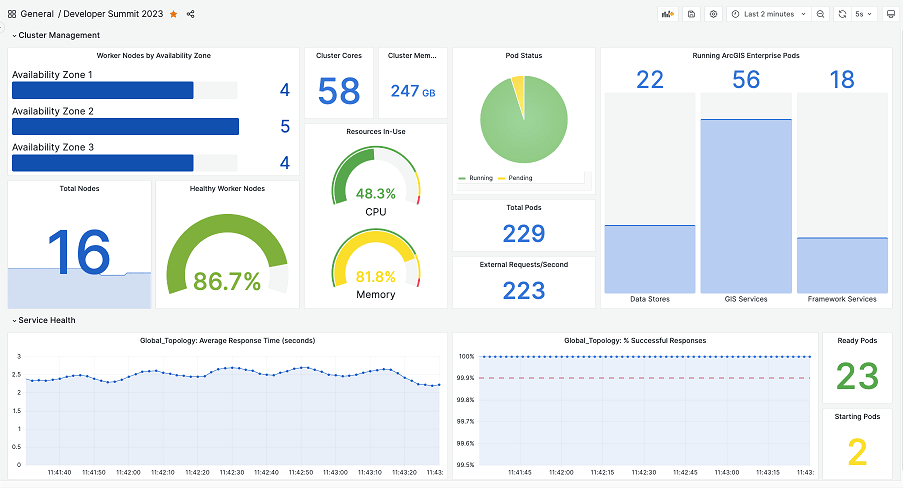Organizations looking to web-enable their GIS data should have confidence when choosing their deployment solutions. For organizations looking to leverage a Kubernetes platform as part of their deployment, they should have confidence that it will be resilient when the system is faced with unexpected demands, confidence that—if something does happen—the system is quick to respond without the need for system administration to intervene, and confidence that—no matter what—the deployment will remain stable.
In his plenary demonstration, Chris shows how ArcGIS Enterprise on Kubernetes can help provide this confidence by ensuring that deployments are highly-available, scalable, and resilient.
Meeting resiliency with unpredictability
For his demonstration, Chris has set up an ArcGIS Enterprise on Kubernetes deployment. Chris shows us his Grafana dashboard to highlight the current properties of the cluster:
- Almost 70 cores
- 264GB RAM
- Almost 230 running pods (including stateful sets, published and system services, and framework application pods)

Chris will reference this Grafana dashboard throughout his demonstration to check in on how the cluster is performing.
At this time, everything is fine in the deployment. But to test its resilience, Chris needs to unleash a level of chaos into the cluster—specifically, an implementation of chaos monkey.
A chaos monkey is a tool that allows infrastructure engineers to introduce disorder into their system. For this demonstration, it has the privileges to terminate nodes at random, without warning.
As the chaos monkey does its job terminating nodes, Chris once again uses his Grafana dashboard to show how this is impacting the cluster.

We can see that replacement nodes are being added to each availability zone to help the cluster return to its desired state. And though there are small variations in the average response time, there is no observable difference in behavior.
Conclusion
Chris demonstrated how an ArcGIS Enterprise on Kubernetes deployment can give organizations confidence that their deployment will remain resilient when met with unpredictability. The scalability of the cluster and published services ensured that user workflows remained available, with no impact on response time. Critical services remained operational while the system recovered from the havoc the chaos monkey wreaked on the cluster.
For more information on ArcGIS Enterprise on Kubernetes, and to see if this deployment solution is the right one for your organization, use the links below to reference our documentation and other blogs:
- Introduction to ArcGIS Enterprise on Kubernetes
- Determine whether Kubernetes is right for you
- Frequently asked questions about Kubernetes
Did you miss the other features showcased in today’s plenary? Do you want to revisit the demonstrations from our talented coworkers? You can find links to other companion blogs in our Dev Summit 2023 overview.
Commenting is not enabled for this article.